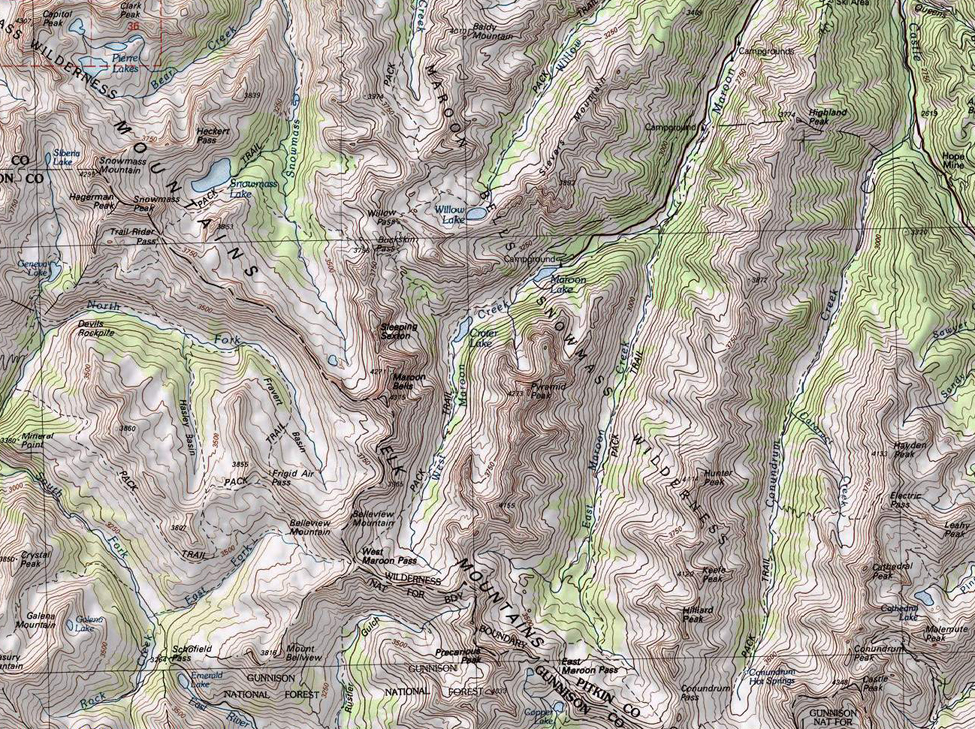The Elk Mountains cover a large portion of mid-western Colorado and are home to some of the most impressive and famous mountains in North America. In fact, the Maroon Bells are the most photographed peaks in Colorado. There's truly no wonder as to why - the Maroon Bells are certainly quite serene and spectacular. My personal obsession with these mountains is so much that the mountain image in the 100summits.com logo is the Maroon Bells, the photo provided by KAEphotography.com. Many of the photos used in this article were taken by Kane of KAEphotography and are being used with his permission.
The Elk Mountains contain some of the most beautiful and majestic wilderness in all of America. There are 3 Wilderness Areas within the Elk Mountains, including the Maroon Bells-Snowmass Wilderness Area, the West Elk Wilderness Area, and the Raggeds Wilderness Area. In total, the Elk Mountains have 423,320 of Wilderness acreage.
A topographical map of the Elk Mountains (Maroon Bells-Snowmass Wilderness Area)
Maroon Bells-Snowmass Wilderness Area
In 1964, Congress recognized that this part of the country was truly special, and as such designated this part of the Elk Mountains, a Wilderness Area. The Maroon Bells-Snowmass Wilderness Area was one of the original five Colorado wilderness areas designated by the Wilderness Act. Originally, the legislature protected only part of this area; however, in 1980, Aspen conservationists lobbied Congress to expand the area to include Mount Sopris, Castle Peak, and the lower reaches of Conundrum Creek valley.
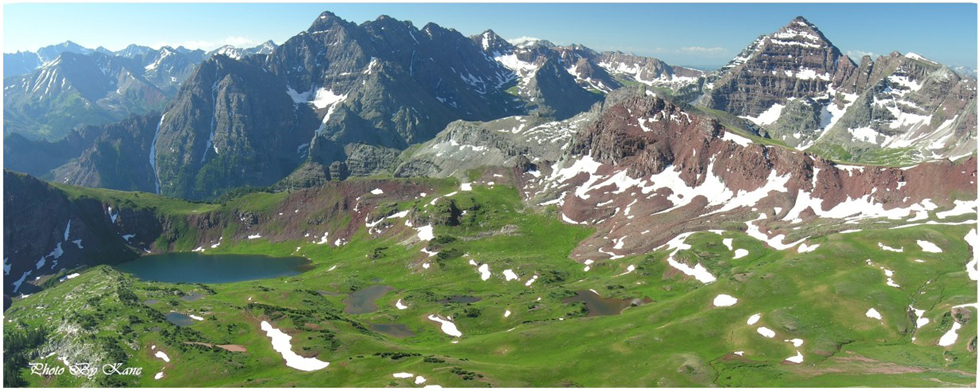
Maroon Bells-Snowmass Wilderness Area - Photo by KAE Photography
As mentioned, the most popular area within the Elk Mountains is the Maroon Valley, home of the Maroon Bells. Due to the popularity there, shuttle buses operate during the summer months (approximately mid-June through Labor Day, plus weekends in September) to Maroon Lake Wilderness Portal. The geologic uniqueness of this area makes it one of the most aesthetically pleasing places in all of Colorado. The rock here is purple-red in hue, and the peaks are magnificent to behold.
The Maroon Bells-Snowmass Wilderness Area offers up some of the finest and most difficult summits in all of Colorado, including the Maroon Bells and Pyramid Peak, both accessible by a non-wilderness, paved road to Maroon Lake. If you're into backpacking, this area offers some of the most rewarding backpacking scenery in the State, including long hikes to Snowmass Mountain or Capitol Peak.

Elk Mountains - Pyramid Massif - Photo by KAE Photography
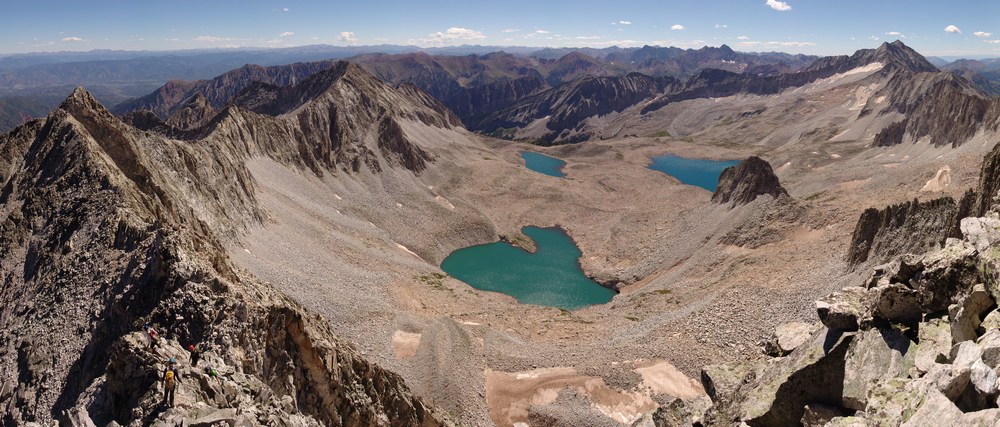
Snowmass Basin as seen from the summit of Capitol Peak - photo by Matt Payne
The West Elk Wilderness Area comprises a remote, mountainous, and geologically unique area west of Gunnison, Colorado. The West Elk Wilderness Area is the fifth largest Wilderness Area in Colorado. This region resides south of Kebler Pass, which runs east from Paonia State Park to the ski resort town of Crested Butte, and south to the Curecanti National Recreation Area. The volcanic ridges and long valleys offer extensive hiking and climbing. Over 200 miles of trails are available for both foot and horse travel through this sometimes-rugged terrain. Elevations within the Wilderness range from 7,000 to over 13,000 feet. If solitude is what you are looking for, you found the right mountain range. Because the area lacks fourteeners, centennial thirteeners and numerous alpine lakes, you will get the benefit of hiking alone and away from the typical recreational visitor. The 500-foot spires called "The Castles" are the signature landmark for the West Elk Wilderness Area. With craggy summits, broad ridges, long valleys, and an intertwined trail network, the options for exploring seem endless.
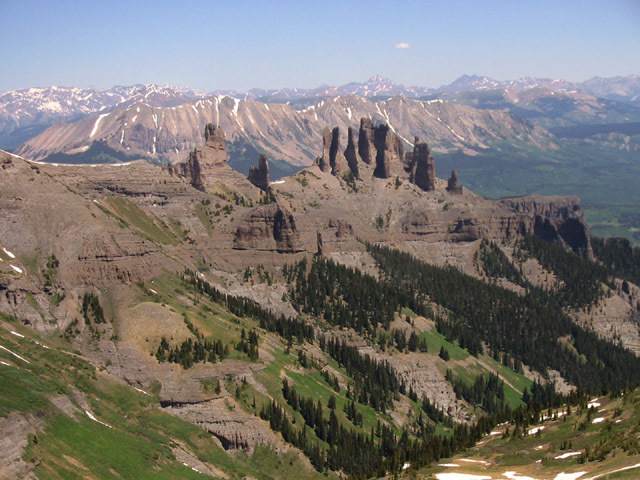
The Castles - Photo by Jon Bradford
From late September into early October, the West Elk Wilderness explodes into a photographer's dream - bleeding yellows, golds, reds, and greens during the fall foilage change.

West Elk Wilderness Area - Photo by KAE Photography
Quite appropriately named, the Raggeds Wilderness Area is a jagged collection of prominent rocky slopes rising to a serrated ridge. Highly visible from Highway 133 over McClure Pass, the Raggeds jut upwards, challenging climbers, hikers, and photographers with their allure. Complementing the Wilderness Area, the Dark Canyon of Anthracite Creek roars below, carving a deep and mysterious gorge through surrounding benchlands of aspen and spruce. Colorful peaks and prominent intrusive dikes of the Ruby Range angle north through the area's eastern end, perpendicular to the Raggeds. Capping the diversity of landforms in this area, the Oh-Be-Joyful Valley, one of Colorado's loveliest glacial valleys, sweeps out from the range toward Crested Butte and the Slate River.

The Raggeds Wilderness Area - Photo by KAE Photography
The aspen forests north of Kebler Pass form one of the area's most gorgeous scenes. In fall, aspen groves on the benches above Anthracite Creek create a patchwork quilt of gold and green as aspen trees change color.
Spearheaded by the town of Crested Butte, which depends on the valley's watershed, an outpouring of citizen support to protect Oh-Be-Joyful led Congress to add it to the Raggeds Wilderness in 1993. Few areas have overcome such overwhelming odds to be designated wilderness as did the Oh-Be-Joyful Valley.Source - John Fielder & Mark Pearson: "The Complete Guide to Colorado's Wilderness Areas."
Mountaineering in the Elk Mountains presents challenges, high risks, and high rewards. Beginner and experienced climbers alike misunderestimate the difficulty on some of the higher summits in the Elk Mountains, such as the Maroon Bells, Capitol Peak, and Pyramid Peak. However, with solid knowledge, good preparation, and sound judgement, most climbers can be highly successful at attaining the summits of even the most challenging mountains in the Elks. For more information, please read my article on Mountaineering Safety. Make sure you have adequate gear before undertaking an adventure in the Elk Mountains. A great place to purchase gear is backcountry.com or rei.com!
The Elk Mountains can be broken into two distinct types of rock: the tertiary intrusives, and the stratified sedimentary. The whitish, gray rock of the tertiary intrusives is responsible for the sweeping, skinny ridges that connect point-to-point, evident in Snowmass Mountain, The Beckwith’s, Capitol Peak and the Chair Mountain massif. Second, the stratified purplish-red, sedimentary rock of the Permian age, which has been pushed upward to form towering stacks of rotten and crumbling rock, like Cathedral Peak, Teocalli Mountain, Pyramid Peak, Maroon Bells and Buckskin Benchmark. Combining these two types of geology with its lush, green vegetation, the geologic uniqueness of the Elk Mountains provide one of the most beautiful and complex landscapes in all of Colorado. According to cliffshade.com (reposted with permission):
The Elk Mountains were formed around 34 million years ago, when Oligocene magmas intruding the Colorado Mineral Belt along lines of weakness left over from Late Proterozoic continent building hit the all-sedimentary Elk Mountain anticline and the adjacent Sawatch uplift particularly hard. In the Elk Mountains, magmas—mostly granodiorites and quartz monzonites—spread out horizontally and unevenly along the Elk Mountain Thrust to pool in two large intrusive bodies known as the White Rock and Snowmass plutons. In doing so, the intrusions further uplifted the overlying Maroon Basin sediments in a process known as magmatic inflation.
Mid-Tertiary magmas reached the surface in great volume in the nearby West Elk Mountains and in the San Juan Mountains, but volcanism may or may not have occurred in the Elks. Any Elk Range volcanics that did erupt are long lost to erosion.
Continued high heat flows and a substantial gravity low along the Colorado Mineral Belt together suggest the ongoing presence of large, hot magma bodies at depth. These are presumably the deep reservoirs that fed the mid-Tertiary Elk Range intrusions, but the story may go deeper yet. Tomographic imaging reveals a broad region of unusually low seismic velocity known as the Aspen anomaly in the upper mantle beneath the Sawatch Range and Elk Mountains. Whether this hot mantle resides in the asthenosphere or in the lithospheric mantle remains unclear, but it may be generating melts either way.
Directly or indirectly, the Oligocene intrusions deserve much of the credit for the great heights, the sheer topography and the uncommon majesty that together set the Elks apart from other Colorado ranges. The tough, medium- to fine-grained, light-colored Elk intrusives tend to form prominent peaks like Mt. Sopris in the north and Castle Peak in the south. The intense heat and mineral-rich fluids the molten intrusions injected into the surrounding sediments altered the latter in several ways. The Mississippian Leadville Limestone acquired rich deposits of zinc, silver and gold, mostly in combination with the lead sulfide ore known as galena. In the late 1800s, this legacy turned Aspen and Leadville into world-famous mining centers. Near the town of Marble, the Treasure Mountain intrusion recrystallized gray Leadville Limestone into the exquisite gleaming white Yule Quarry Marble of Lincoln Memorial and Tomb of the Unknown Soldier fame. A large sill (slab-like horizontal magma body) intruding the Maroon Formation along the Elk Mountain Thrust baked and basted the normally dark red beds of the Late Pennsylvanian through Permian Maroon Formation into the hard, handsome maroon strata of the Maroon Bells and the durable gray-green hornfels of the Cathedral Lake basin.
Sources: Jon Bradford, Summitpost.org; Jeremy McCreary, cliffshade.com
Below is a grid overlayed onto a map of the Elk Mountains. Each grid corresponds to a USGS 1:24,000-scale topographic map. Click on the number to bring up the map for that area. Be warned, the maps are quite large!
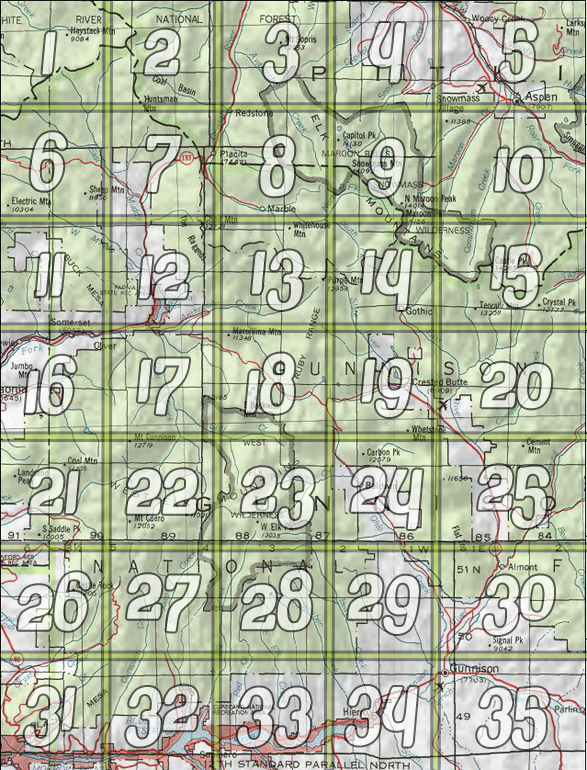
The following acts are prohibited on National Forest System land within the Maroon Bells-Snowmass Wilderness:
1. Entering or being in the area with more than 10 people per group, and a maximum of 15 pack or saddle animals.
2. Camping: (a) within one hundred feet of any lake, stream, National Forest System Trail, or any "No Camping" or "Wilderness Restoration Site" sign or; (b) within 1/4 mile of Copper Lake, Conundrum Hot Springs, Crater Lake, Geneva Lake, Capital Lake, and Thomas Lakes, except at designated campsites.
3. Building, maintaining, attending or using any campfire within one hundred feet of any lake, stream, or National Forest System trail or within 1/4 mile of treeline, above treeline, within the entire Bear Creek drainage or; within 1/4 mile of Crater Lake, Conundrum Hot Springs, Copper Lake, Geneva Lake, Capital Lake, Snowmass Lake or Cathedral Lake.
4. Storing equipment, personal property, or supplies for longer than 7 days.
5. Hitching, tethering or hobbling any pack or saddle animal within one hundred feet of any lake, stream or National Forest System Trail or; within 1/4 mile of Crater Lake, Conundrum Hot Springs or Snowmass Lake.
6. Possessing a dog, except for working stock dogs or dogs used for legal hunting purposes, unless under physical restraint of a leash not to exceed six feet in length.
7. Possessing a dog, except a service dog assisting a disabled person, within 1/4 mile of Crater Lake, except on the West Maroon or Maroon-Snowmass Trails or within 1/4 mile of Conundrum Hot Springs, including designated stove sites #7-13.
8. Possessing, storing or transporting any plant material, such as hay or straw. NOTE: exceptions are allowed for livestock feed that has been processed through chemical or mechanical means in a manner that will destroy viable seeds. Examples of allowed material include: pelletized feed and rolled grains.
9. Possessing or using a wagon, cart or other vehicle including a wheelbarrow or game cart.
10. Shortcutting a switchback in a trail.
11. Entering in or being in the Maroon Bells-Snowmass Wilderness without a valid wilderness use permit.
Find out the avalanche conditions in the Northern Elk Mountains
Find out the avalanche conditions in the Southern Elk Mountains
Find all summits in the Elk Mountains


